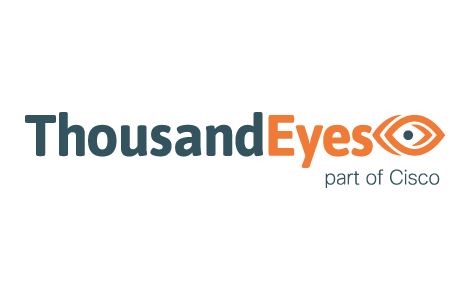ThousandEyes
Last Updated:
Analyst Coverage: Paul Bevan
ThousandEyes was founded in 2010 in San Francisco by Mohit Lad and Ricardo Oliveira. They had seen that the Internet was on its way to becoming the new enterprise backbone, and that it would become the medium by which every company would conduct its business.
Rightly, they understood that this development would have significant implications for the management of end-to-end infrastructure performance for network and IT operations teams in large enterprises and that this would need the development a very different Internet and Cloud monitoring solution. Bloor has been highlighting this network visibility gap in a series of reports and articles dating back to 2018.
Cloud Agents, maintained by ThousandEyes, provide globally distributed vantage points throughout the Internet. They are located in 200 cities and are connected to Tier 1, 2 and 3 ISPs, broadband service providers and regional data centers of major cloud providers.
Enterprise Agents provide visibility from within data centres, cloud VPCs/VNETs and branches. In addition to active monitoring, Enterprise Agents also offer SNMP-based monitoring, as well as discovery and topological mapping of internal network devices.
Endpoint Agents offer end user experience monitoring and deploy on Mac and Windows devices. Periodic user monitoring is performed via HTTP and network monitoring tests that include insight into routing paths. Real-time monitoring can be enabled via an optional browser-based plugin.
This breadth of network monitoring capabilities provides a unique intelligence on the performance and availability of the public internet and the networks of major cloud providers as seen in its regular Internet and Cloud Performance reports. In addition to monitoring for outages and performance degradation, customers can also benefit from advice on best routing options, helping them design the most effective network architecture for globally distributed operations.
A recent new addition to the platform is ThousandEyes WAN Insights, which provides network forecasts and SD-WAN recommendations to optimize user experience across enterprise sites. Another new addition is ThousandEyes for OpenTelemetry which brings data standardization and portability to the ThousandEyes platform, sending ThousandEyes network metrics in a standardized format to any OpenTelemetry (OTEL) supporting platform. ThousandEyes believes it is the first network visibility platform to be OTEL compliant, sharing its Internet and Cloud Intelligence across a wide range of other solutions.
It has an impressive list of global commercial, financial services and communications carrier organisations as customers.
In August 2020 ThousandEyes was acquired by Cisco as a key component of its strategic focus on supporting its initiatives for Hybrid Work and Full Stack Observability (FSO), as well as delivering visibility into SD-WAN and SASE environments. It complements other Cisco acquisitions in this area, most notably, AppDynamics. ThousandEyes is careful to stress that it is a monitoring, not an Observability tool. However, it undoubtedly brings significant and highly differentiated capabilities to the Cisco FSO solution, Webex, Meraki and Cisco SD-WAN platforms while itself benefiting from the scale, scope and market presence of Cisco itself.
Commentary
Solutions
- ThousandEyes



